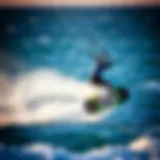Kitesurfing Lessons in Puerto Rico: A Complete Guide
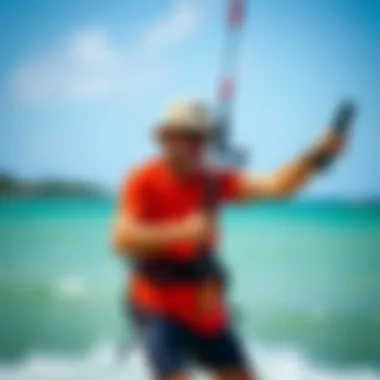
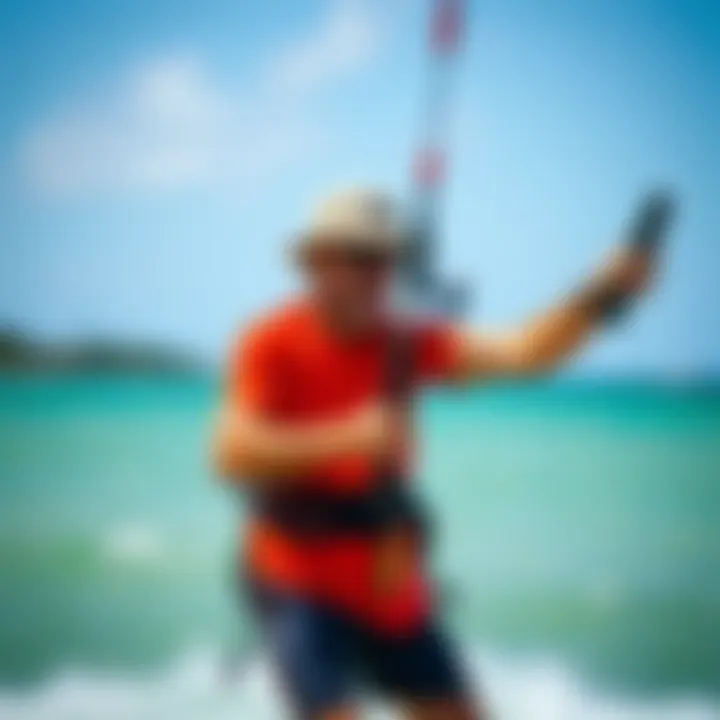
Intro
Kitesurfing has seen a surge in popularity over the last few years, with many outdoor enthusiasts flocking to landscapes that marry beautiful beaches with the thrill of surf. Puerto Rico, with its vibrant culture and stunning coastlines, offers a unique backdrop for kitesurfing lessons. From the beginner trying to grasp the basics to seasoned veterans keen on honing their advanced techniques, there’s something for everyone in this Caribbean paradise. In this article, we will delve into the nitty-gritty of kitesurfing lessons available in Puerto Rico, shedding light on the equipment, techniques, and safety practices that make the experience both exhilarating and secure.
Equipment Insights
When setting out to learn or advance in kitesurfing, having the right equipment is crucial. The gear you choose not only affects your performance on the water but also your overall enjoyment and safety. In Puerto Rico, notable local shops like Ocean Pro and Kiteology cater specifically to kitesurfers and provide up-to-date gear tailored to the conditions of the region.
Latest Gear Reviews
Let's take a closer look at some must-have equipment for kitesurfing:
- Kites: Brands such as Naish and Cabrinha offer versatile kites suitable for a variety of conditions. The Naish Pivot stands out for its user-friendly design, making it an excellent choice for beginners. For more advanced riders, the Cabrinha Switchblade delivers exceptional handling and power control.
- Boards: The right board can make or break your session. Slingshot and F-One produce boards that range from beginner-friendly to high-performance. The F-One Trax is particularly known for its stability and ease of use, while the Slingshot Terminator excels in freestyle performance.
- Safety Equipment: Don’t overlook the importance of safety gear. A quality harness, such as the Mystic Warrior, coupled with a reliable impact vest, keeps you protected in case of falls.
Essential Gear Maintenance
Taking care of your gear extends its lifespan and enhances safety. Here are some tips:
- Regular inspections: Check for any frays or damages on your lines and kites. A small tear can lead to significant problems when you're out navigating the waves.
- Cleaning: Rinse your gear with fresh water after every session to remove salt and sand that can wear it down.
- Storage: Store kites and boards in a cool, dry place. Avoid leaving them in direct sunlight for prolonged periods, as UV rays can damage the materials over time.
Technique Exploration
Once you have your equipment sorted, diving into techniques is the next logical step. Whether you're on the calmer waters of La Parguera or tackling the waves at Jobos Beach, refining your skills is key to enjoying the sport more fully.
Beginner Techniques
Starting with the basics is essential for safety and confidence. Here are some fundamental techniques:
- Body Dragging: This technique helps you understand kite control without the added challenge of the board.
- Waterstarting: Learning to get up on the board from the water is a critical skill. Practicing this in shallow areas can ease the learning curve.
- Riding Upwind: This is a pivotal skill for kitesurfing, allowing you to return to your starting point.
Advanced Maneuvers
For those with a few hours under their belt, testing your limits with advanced techniques can be invigorating. Some popular maneuvers include:
- Jumping: This requires good timing and kite control. Practice small hops before attempting larger leaps.
- Tricks: Once you're comfortable with jumping, diving into tricks like the backroll or frontroll can elevate your kitesurfing experience.
Safety Practices
Finally, it's vital to keep safety front and center in your kitesurfing adventure. Always wear a helmet, check wind conditions, and land in designated areas. Get familiar with the local rescue protocols and consider taking a lesson from certified instructors to understand the nuances of the sport better.
Through understanding equipment, mastering techniques, and adhering to safety practices, you'll not only enjoy the thrill of kitesurfing in Puerto Rico but also foster a passion for a sport that continues to grow in popularity. The combination of stunning scenery, friendly locals, and a community of skilled instructors makes Puerto Rico an ideal place for both novice and advanced kitesurfers alike.
"Kitesurfing is more than just bending the wind; it's about harnessing freedom on the water and connecting with nature in a way few other sports allow."
Prologue to Kitesurfing
Kitesurfing has exploded in popularity over the last few decades, drawing thrill-seekers to stunning locations across the globe. In this article, we delve into the world of kitesurfing, particularly focusing on the vibrant opportunities available in Puerto Rico. Understanding kitesurfing is vital because it not only reveals the physical and mental benefits of engaging in this thrilling sport but also emphasizes the outdoor experience it offers. The wind in your hair and the splash of ocean waves create an exhilarating blend of freedom and adventure.
Understanding the Sport
At its core, kitesurfing marries the skillful manipulation of a kite with the dynamic movement of a surfboard or a wakeboard. Once the kite is airborne, it harnesses the wind, propelling the rider across the water. This unique sport requires a blend of balance, core strength, and intuition, making it both a challenge and a source of joy for participants. Kitesurfing is not just about riding the waves; it’s about becoming one with nature, learning to read the wind, and mastering your body’s movements in response to varying elements.
For beginners, the adaptability of the sport makes it approachable. You don’t have to be a seasoned athlete to take off—many first-timers quickly develop a love for the sport with proper instruction and practice. Furthermore, the adrenaline rush that comes from navigating the water can also serve as a terrific stress relief, a perfect antidote to the hustle and bustle of everyday life.
History and Evolution
Kitesurfing’s roots trace back to the late 1970s but it was not until the 1990s that the sport began to take off on a broader scale. Emerging from the blend of various wind sports, including surfing and kite flying, kitesurfing has seen significant innovations in equipment and techniques. The early days featured bulky kites and rudimentary boards, but advancements in technology have transformed kites and harnesses into sophisticated, lightweight apparatuses.
From humble beginnings, the sport has evolved significantly, with a thriving community that fosters innovation and shared experiences. The introduction of different styles such as freestyle, wave riding, and racing has opened up avenues for personalized expression and competition, allowing kitesurfers to tailor their practice according to their preferences.
It's essential to recognize that with this evolution has come a greater focus on safety and environmental considerations, ensuring that kitesurfing remains sustainable while providing thrills. As the sport grows, so does the responsibility of riders to respect coasts and marine life, which are integral to the kitesurfing experience.
In summary, understanding kitesurfing not only enriches one’s appreciation for the sport but also illustrates its historical significance and adaptive nature. With a backdrop like Puerto Rico, the allure of kitesurfing offers both adventure and connection to an expansive, lively community.
Puerto Rico as a Kitesurfing Destination
When it comes to kitesurfing, Puerto Rico is nothing short of a paradise. The combination of its stunning natural beauty, consistent wind patterns, and vibrant local culture makes it an ideal location for both beginners and seasoned enthusiasts. The island boasts an array of kitesurfing lessons, tailored to suit diverse skill levels, and numerous spots where one can hone their skills or simply enjoy the thrill of the wind beneath their kites.
Kitesurfing in Puerto Rico does not merely revolve around the sport itself; it’s about the experience. From the warm Caribbean waters to the gorgeous sandy beaches, every aspect of the setting complements this exhilarating activity. Moreover, the island has developed a significant kitesurfing community, contributing to a sense of belonging for both locals and visitors.
Geographical Advantages
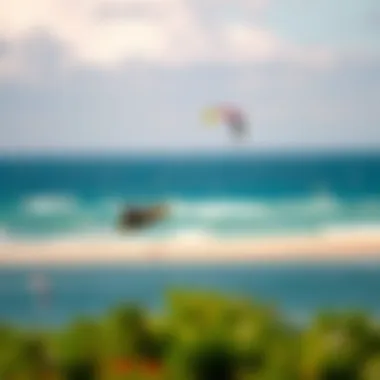
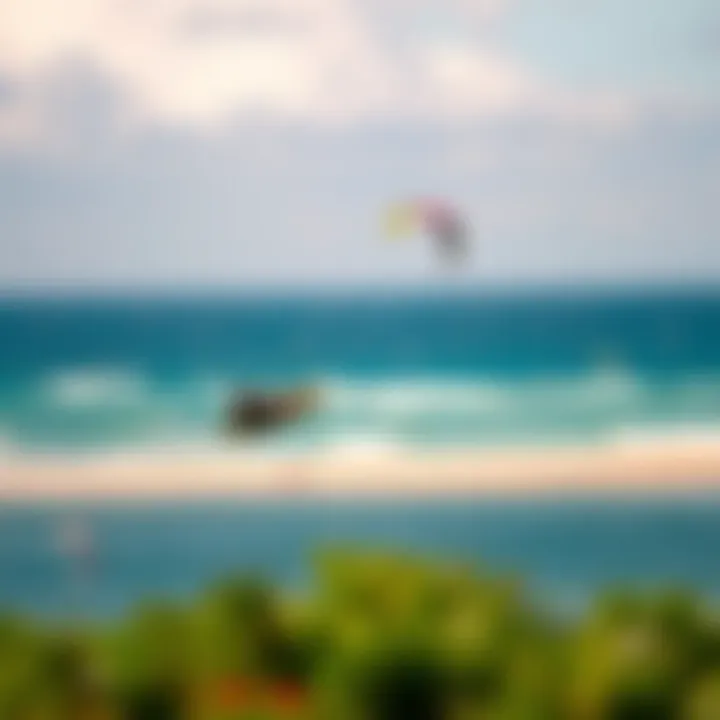
Situated in the Caribbean Sea, Puerto Rico enjoys geographical perks that are hard to find elsewhere. The island's coastline is peppered with countless beaches that are not only breathtaking but also offer varying wave conditions suitable for kitesurfing. The geographical diversity ranges from sheltered coves to more open areas expose to stronger winds, catering to different preferences.
given the island's compact size, aspiring kitesurfers can easily explore multiple locations in a single trip. This accessibility encourages exploration and discovery, enhancing the overall kitesurfing experience. The wind, consistent and reliable, is another plus, making it possible to catch the perfect breeze without extensive planning.
Climate and Weather Conditions
One cannot talk about kitesurfing without mentioning weather. Puerto Rico’s tropical climate is characterized by warm temperatures, year-round sunshine, and steady winds, creating prime conditions for kitesurfing almost any time of the year. The trade winds, which typically blow at an average of 15 to 25 knots during the kite season, make the island a very attractive spot for kitesurfers.
From December to August, conditions are particularly favorable as the winds tend to be more consistent. This season allows novices to learn swiftly, while seasoned surfers can enjoy new challenges. The inviting waters lend a sense of comfort, making the entire experience not only thrilling but also accessible.
Popular Kiting Locations
-#### Isla Verde Isla Verde stands out as one of the principal kiting spots in Puerto Rico, known for its smooth, powdery sands and clear waters. This location attracts kitesurfers for good reason, not least of which includes the backdrop of elegant hotels and restaurants nearby. Isla Verde’s waves are typically gentle, providing safe conditions for novices while still offering a bit of excitement for the more experienced rider. The vibrant atmosphere and easy accessibility from the San Juan Airport make it a top choice for travelers eager to jump into the action. However, its popularity can sometimes mean busier beaches, which might not suit those seeking solitude.
-#### Rincón
On the western coast, Rincón is often hailed as the kitesurfing capital of Puerto Rico. It features stunning sunset views and a more laid-back vibe compared to Isla Verde. Rincón's beaches, like the famed Sandy Beach, cater well to kitesurfers, offering both flat water and waves that challenge even the most skilled riders. The unique aspect of this spot is its community feel, where local instructors and surfers interact closely. This place can get quite crowded, especially during peak seasons, yet it's this very atmosphere that fosters camaraderie and learning.
-#### Cabarete
While technically not in Puerto Rico, Cabarete in the Dominican Republic is often grouped with the island’s popular kiting spots. Renowned for hosting numerous international kiting competitions, Cabarete attracts pros and hopefuls alike. Its beaches, paired with consistent winds, provide ample opportunities for kitesurfing enthusiasts to test their skills. What sets Cabarete apart is the diversity of its beach scene, where one can find both partying and peaceful relaxation. Though it's a bit of a trek from Puerto Rico, many kitesurfing enthusiasts think it’s worth the trip for the extraordinary experience.
Types of Kitesurfing Lessons Available
Kitesurfing offers a thrilling blend of adrenaline and beauty, particularly on the scenic shores of Puerto Rico. Understanding the various types of lessons available is critical for anyone keen on diving into this sport. Tailored instruction can make the difference between a joyride and a learning curve. Not only does quality training enhance your skills, but it ensures safety, enjoyment, and retention of the adrenaline-fueled joy that kitesurfing provides. Whether you are just starting or looking to advance, there’s a lesson type that fits your needs.
Beginner Lessons
Beginner lessons serve as the foundation for students new to kitesurfing. These sessions focus on the essential skills required to control the kite, such as launching and landing safely, basic kite handling, and understanding wind directions. Instructors often emphasize safety and how to self-rescue.
"Starting with a solid understanding is like building a house on a strong base—it saves you from future falls!"
Typical structures of a beginner course include:
- Introduction to Equipment: Understanding the kite, board, and safety gear.
- Wind Theory: What learners need to know about the wind and its impact on kitesurfing.
- Water Safety: Important considerations for operating safely in various conditions.
- On-Land Practice: Practicing kite control on land before hitting the waves.
As students progress through these lessons, they typically advance to water starts under direct supervision, gaining hands-on experience in a controlled environment.
Intermediate and Advanced Lessons
Once beginners demonstrate a solid grasp of fundamental skills, they may progress to intermediate and advanced lessons. These classes delve deeper into techniques such as jumping, tricks, and navigating in challenging conditions. The focus shifts to refining skills to enhance performance.
Intermediate lessons often cover:
- Controlled Jumps: Techniques for ascending and descending smoothly.
- Trick Development: Learning spins and aerial tricks.
- Kite Loops: Understanding how to perform powerful maneuvering during rides.
Advanced instruction moves learners beyond basic skillsets, focusing intensely on:
- High-Level Tricks: More complex aerial maneuvers.
- Celestial Navigation: Understanding how to read the water and wind for optimal performance.
- Self-Sufficiency Techniques: Skills for independent riding, assessing conditions, and problem-solving.
Experienced instructors tailor these lessons based on individual goals, fostering a personalized learning experience that challenges the student without overwhelming them.
Private vs. Group Lessons
Choosing between private and group lessons comes down to personal preference and learning style. Both formats have unique advantages that can cater to different types of learners.
- Private Lessons: These are perfect for those who prefer one-on-one instruction. The instructor’s full attention allows for tailored lessons that align closely with the learner's pace and goals. It’s also ideal for addressing specific skills or issues.
- Group Lessons: On the flip side, group lessons can be a great way to meet new friends who share your interests. Additionally, they can lower the cost per person while still providing a comprehensive learning experience. Training alongside others can also foster a supportive community atmosphere.
Each format has its merits, and the choice ultimately hinges on what the student aims to achieve. Regardless of the choice, quality instruction is the cornerstone of becoming a skilled kitesurfer in the resplendent waters of Puerto Rico.
Choosing the Right Instructor
When it comes to kitesurfing, having the right instructor can make a world of difference. Your journey into this exhilarating sport requires guidance that is not just competent but also tailored to your individual needs and skill level. An excellent instructor not only teaches the technical aspects but also instills confidence, which is crucial in a sport that involves wind, waves, and hardware.
Qualifications and Experience
An instructor's qualifications and experience are paramount when choosing who will guide you through kitesurfing lessons. You will want someone who not only understands the sport but also the local conditions of Puerto Rico’s beaches. Aspects such as wind patterns, current behaviors, and local regulations can greatly affect your experience. An instructor with significant teaching experience can often read the water like a book, anticipating changes that a novice might overlook.
The ideal candidate should have formal training in kitesurfing, ideally with certifications from recognized organizations. Consider instructors who have logged substantial hours teaching students across various skill levels. This can provide you with a sense of security knowing that you’re learning from someone who has successfully helped others like you.
"Experience is the best teacher, but the lessons can be smoother with a qualified guide."
Here are some qualifications to look for:
- International Kiteboarding Organization (IKO) Certification: A global standard in kitesurfing instruction.
- Local Understanding: Familiarity with Puerto Rico’s unique geography and its impact on kitesurfing conditions.
- First Aid Training: Safety is crucial in any sport; it’s essential your instructor is prepared for emergencies.
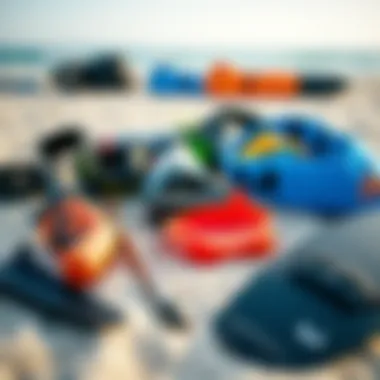
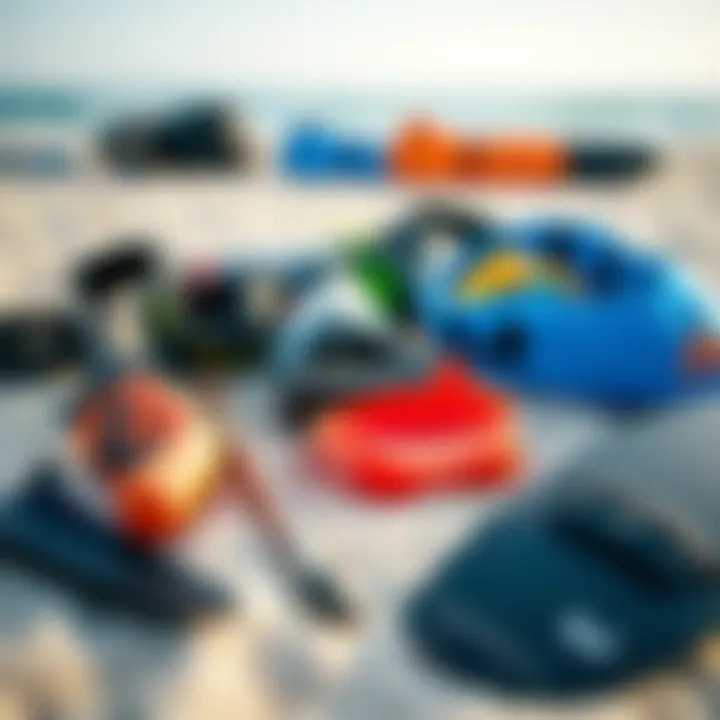
In summary, an instructor's qualifications and experience not only lay the foundation for your learning journey but also enhance your safety and confidence in the water.
Certifications and Affiliations
When it comes to kitesurfing instruction, certifications signify adherence to specific standards and practices. An instructor’s affiliation with established organizations can be a solid indicator of their credibility. Organizations like the International Kiteboarding Organization (IKO) and the Professional Air Sports Association (PASA) provide guidelines that prioritize safety and teaching effectiveness.
Here’s why checking for certifications matters:
- Credibility: Certified instructors have demonstrated their knowledge and skill in a structured way.
- Structured Lessons: These certifications often require teachers to follow a curriculum that has been fine-tuned for optimal learning.
- Access to Continued Education: Instructors who are affiliated with professional bodies tend to pursue ongoing education, keeping them up to speed with the latest in kitesurfing techniques and safety practices.
Furthermore, local schools affiliated with significant water sports organizations frequently partner with these certifying bodies to create training programs that meet or exceed international standards. This means that by choosing a recognized school, you're likely to receive a higher-quality education.
It's important to engage with potential instructors or schools; ask them about their qualifications and affiliations. Understanding their background can help you select someone who not just wants to teach you how to kitesurf, but really wants to see you succeed and enjoy the sport.
For resources and further reading on qualifications relevant to kitesurfing, you can check International Kiteboarding Organization and Professional Air Sports Association.
Choosing the right instructor can set the tone for your entire kitesurfing experience, so it’s worth taking your time to find someone who fits the bill.
Safety Considerations in Kitesurfing
Kitesurfing, while exhilarating, comes with its fair share of risks. Thus, honing in on safety considerations is essential, especially when you're aiming to ride those waves in Puerto Rico. Understanding local conditions, ensuring your gear is up to par, as well as adopting personal safety measures creates a foundation for a safe and enjoyable experience.
Understanding Local Conditions
Puerto Rico stands out with its diverse environments, which means local conditions can vary. Factors like winds, tides, and sea currents are pivotal for kitesurfers. For instance, in Rincón, the famous surf beaches provide powerful wind conditions. But new kitesurfers should be cautious; the currents can turn deceptively strong during certain tides.
It's crucial to check local resources that provide wind and weather reports. Websites such as Windy or local kitesurfing schools often publish updates on optimal kiting conditions. This info can save you from both unexpected challenges and potential hazards.
In casual conversations among surfers, you might hear, “When in doubt, wait it out.” It’s sometimes better to delay your session until conditions are favorable rather than diving in recklessly.
Equipment Safety Checks
Kitesurfing gear is subject to wear and tear. Hence, equipment safety checks serve as your first line of defense. Prior to each session, take a moment to go through a checklist:
- Kite Integrity: Look for any rips or leaks. Small damages can escalate quickly when under pressure.
- Lines and Leashes: Inspect your lines for tangles or frays, as these can lead to accidents.
- Board Condition: Don’t overlook your board. Ensure it hasn’t taken on serious scratches that could compromise performance.
Blockquote: "Regular maintenance is key. A few minutes can save your life or your gear."
Utilizing a systematic approach will help nurture the longevity of your equipment, while simultaneously enhancing your safety margin.
Personal Safety Measures
While environmental awareness and equipment checks are vital, personal safety measures round out your kitesurfing strategy. First off, wearing a helmet can be a game changer. Look for models designed specifically for watersports; they provide support without hindering your vision. Similarly, a life vest can be a lifesaver in turbulent waters. They keep you afloat, should something go awry.
When you’re out on the water, consider kiting with a buddy. Not only does this provide another layer of safety, but having someone to share the experience with makes it far more enjoyable. Always communicate and establish simple signals for emergencies; doing so can be beneficial in case something goes south swiftly.
In essence, being proactive about your safety when kitesurfing in Puerto Rico is non-negotiable. Whether you’re a novice rider or a seasoned pro, these considerations should always be top of mind.
Equipment Required for Kitesurfing
Kitesurfing is a thrilling sport that relies not only on the skill of the rider but also heavily on the equipment being used. The right gear is essential for an enjoyable experience. Each component of kitesurfing gear serves a specific purpose and contributes significantly to both performance and safety. Investing in quality equipment can make the difference between a delightful day on the water and a frustrating experience filled with mishaps. In Puerto Rico, where the winds can shift and the waves can vary, understanding your gear is crucial.
Types of Kites
When it comes to kites, they are not just colorful pieces of fabric soaring through the sky. There are mainly two types: LEI (Leading Edge Inflatable) kites and Foil kites.
- LEI Kites: This is probably the most common type among newbies and professionals alike. They are inflated at the leading edge and provide better stability and power, which is especially helpful in gusty conditions. These kites can often handle rough waters with ease, making them a prime choice for kitesurfers in Puerto Rico.
- Foil Kites: These are less common for kitesurfing but popular for other conditions. They don’t require a pump and can be lighter, but they may not perform as well in turbulent environments. For most kitesurfing needs, particularly in Puerto Rico’s varied conditions, LEI kites stand out as the go-to choice.
Knowing the characteristics of different kites is key in selecting one that suits your style and location.
Boards and Accessories
Boards are as critical as kites in the kitesurfing equation. The choice of board can change your riding experience completely, based on factors like your skill level and conditions. There are predominantly three types of boards: freestyle, freeride, and wave boards. Each is designed for distinct riding styles and conditions.
Wetsuits
Wetsuits bring comfort and safety to your kitesurfing experience. These stretchy garments help maintain body heat in cooler waters, a detail that transforms a bitter chill into something much more bearable. The key characteristic of a wetsuit is its material, often made of neoprene, which holds warmth by trapping water between the suit and the body, creating a layer of insulation.
Many Puerto Ricans may not think about wetsuits due to the tropical climate, but they can still be useful during windier months or after sunset. A well-fitted wetsuit is a beneficial choice because it allows for greater freedom of movement while preventing scrapes and sunburn. Moreover, opting for a wetsuit with more thickness can enhance warmth, but it may affect your mobility slightly.
Harnesses
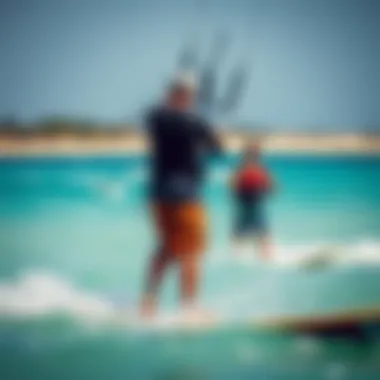
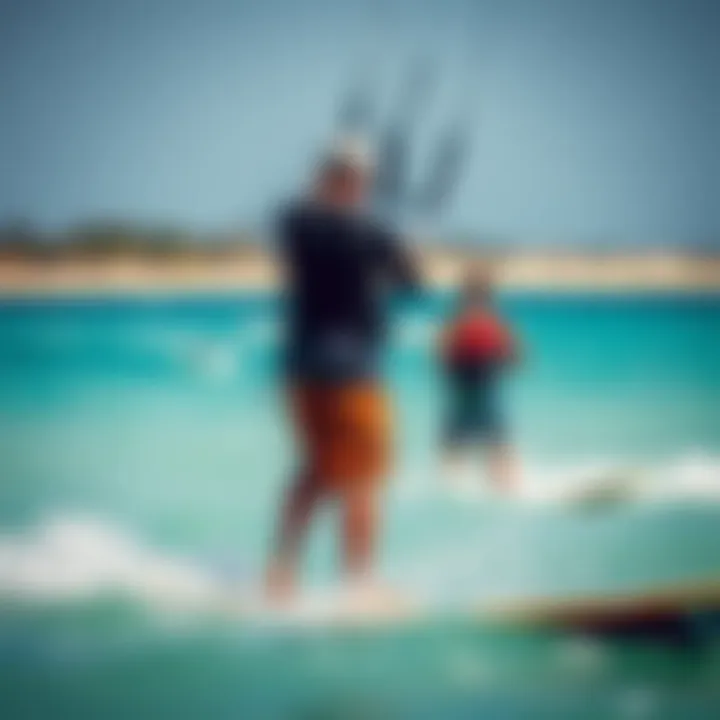
Harnesses connect the rider to the kite, distributing the pull across the body to prevent fatigue. They come in two main styles: waist and seat harnesses. The key characteristic of a harness is how it allows a rider to keep an upright position without straining their arms.
For many kitesurfers, waist harnesses are often preferred as they provide better maneuverability, enabling tricks and freestyle moves. However, they may not offer as much support as seat harnesses for beginners who want to stay comfortable and upright. It’s essential to choose a harness that feels right as it plays a significant role in your riding experience.
Helmets
Helmets might not be the first thought that comes to mind when gearing up for kitesurfing, but they are crucial for safety. Given the speeds and potential falls involved, wearing a helmet can protect against head injuries. They are seldom required, but safety should never be disregarded.
The key advantage of wearing a helmet is straightforward: it offers peace of mind. With the right fit, you won’t even notice it when riding. On the negative side, some helmets can be bulky or create excess heat. Finding a lightweight, well-ventilated helmet can strike the right balance between safety and comfort.
"Kitesurfing is about freedom—make sure your gear enhances that feeling rather than hinders it."
Overall, understanding and selecting the right equipment in kitesurfing is vital. Each piece of gear has its distinct role and contributes significantly to your performance and enjoyment out on the water. Whether you are just starting or brushing up on your skills, investing in the correct equipment will pay off in the long run.
The Role of Local Schools in Kitesurfing Education
Kitesurfing has surged in popularity, and at the heart of this growth lie local schools dedicated to nurturing new talent. These institutions are more than just places to learn the ropes; they serve as community hubs where enthusiasts gather, share experiences, and develop their skills in a supportive environment. The role of local kitesurfing schools in Puerto Rico is crucial, not only for the education of individuals but also for the flourishing of the sport as a whole.
Curriculum Overview
Kitesurfing schools in Puerto Rico offer a diverse range of curriculums tailored to different skill levels, ensuring that both beginners and seasoned riders can find suitable instruction. Beginner courses typically focus on fundamental skills such as understanding wind conditions, basic kite control, and safety protocols. As the learners progress, more advanced classes dive into techniques like jumping and handling stronger winds.
- Beginner Lessons: These classes emphasize kite control, safety, and basic riding skills. The goal is to make students comfortable with the gear and the water.
- Intermediate Lessons: Here, the focus shifts to fine-tuning techniques and introducing tricks like jumping and transitioning.
- Advanced Techniques: For those already versed in the sport, schools offer specialized training that hones specific skills and prepares advanced riders for competitions.
Moreover, schools integrate real-world scenarios into their curriculum, helping students understand how to react to different environmental factors. They address local conditions, which can vary vastly across different kiting spots such as Isla Verde and Rincón. This localized knowledge is crucial for ensuring a safe and enjoyable kiting experience.
Community Engagement and Events
Local kitesurfing schools don’t just stop at education; they also play a pivotal role in community engagement. Many offer events designed to foster camaraderie among kiteboarders. These could range from friendly competitions to beach clean-ups, which help raise awareness about preserving natural water environments.
Such events often feature:
- Competitions: Tournaments are a great way to bring together riders of varied skill levels, providing them an opportunity to showcase their talents and learn from others.
- Workshops: These focus on specific skills or equipment usage, where participants can gain insights directly from experienced instructors.
- Social Gatherings: Events that aren't always focused on the sport, like beach parties or barbeques, help solidify bonds within the community.
Engagement with the broader community helps dispel any misconceptions about kitesurfing. Many locals who may have never considered the sport can encounter it in a friendly and approachable manner, possibly sparking their interest. Moreover, the collaboration with local businesses, environmental organizations, or schools can amplify the outreach of kitesurfing, encouraging a spirit of togetherness while promoting environmental responsibility.
"Kitesurfing is not just a sport; it’s a lifestyle, and local schools ensure everyone feels they are part of it right from day one."
In sum, the importance of local kitesurfing schools in Puerto Rico transcends mere instruction. They cultivate skill, build community, and promote sustainable practices, all of which are vital to the long-term health of kitesurfing in the area.
Sustaining the Kitesurfing Environment
In order to truly enjoy kitesurfing, it’s essential to think about the environment that makes this exhilarating sport possible. Puerto Rico’s stunning coastlines and favorable wind conditions are part of what draws enthusiasts from around the globe. However, as with any outdoor sport, kitesurfing can have an impact on the surroundings. By focusing on sustainability, we not only preserve these beautiful landscapes but also ensure that future generations can relish in the thrill of riding the waves and sky.
Environmental Impact Considerations
Kitesurfing, like any other water-based activity, comes with its own set of environmental responsibilities. The launching and landing zones of kites can be particularly sensitive areas. For instance, if riders frequently use the same spot without consideration, it may lead to soil erosion, damage to local flora, and wildlife disturbances. To keep Puerto Rico’s shores pristine, here are some critical considerations:
- Wildlife Conservation: Many kitesurfing locations are near vital habitats for birds and other marine life. It's crucial to maintain a respectful distance during nesting seasons to avoid disruptions.
- Local Flora: Riders should use designated areas for launching to minimize damage to native plants. Stepping on delicate vegetation can cause irreversible harm.
- Waste Management: Kitesurfing enthusiasts must ensure they pick up after themselves. Litter like plastic bottles and food wrappers can pose serious threats to coastal wildlife and ecosystems.
"The true spirit of adventure is one that embraces nature, preserving its splendor for future explorers."
Informing riders about these issues during lessons can have a lasting impact. Educators play a pivotal role in instilling a sense of stewardship among their students. By embedding these values into lesson plans, local schools can cultivate environmentally conscious kitesurfers.
Promoting Responsible Kitesurfing
Engaging in kitesurfing comes hand in hand with a responsibility to protect the environment that supports the sport. Promoting responsible practices can help mitigate negative impacts while ensuring the sustainability of kitesurfing as a recreational activity. Here are some strategies that can be employed:
- Educational Campaigns: Local kitesurfing schools can run workshops focusing on environmental sensitivity. This isn't just about riding the wind; it’s about understanding the place where we kite.
- Community Cleanups: Organizing beach cleanups not only helps reduce litter but also fosters community spirit. It’s a chance for kiteboarders to bond while giving back.
- Eco-Friendly Gear: Encouraging the use of sustainable gear—like those made from recyclable materials—can contribute to a more eco-responsible kitesurfing community.
- Stay Informed: Keeping abreast of local regulations concerning coastal use is key. This helps kitesurfers make better decisions that align with conservation efforts. Websites like Surfrider Foundation provide resources on local policies and environmental news.
By promoting responsible kitesurfing, we not only enhance our own enjoyment of the sport but also help ensure that our beloved destinations continue to thrive, for those who ride the winds today and for generations yet to come.
Culmination and Future Outlook
As we take a step back to examine the themes woven throughout the exploration of kitesurfing lessons in Puerto Rico, it becomes clear that this is not merely a pastime, but a growing movement that invites both novices and experts alike to ride the winds and waves. Understanding how the kitesurfing landscape evolves is crucial for anyone keen on engaging with this sport, particularly in a vibrant locale like Puerto Rico. This conclusion serves as a call to recognize the sport's expanding popularity and the future innovations that promise to enrich the kitesurfing experience further.
The Growing Popularity of the Sport
The allure of kitesurfing is more potent than ever, as evidenced by a noticeable uptick in both participants and schools offering lessons. The warm waters and consistent winds of Puerto Rico serve as an ideal backdrop, attracting a diverse crowd. From families seeking adventure to solo travelers looking for adrenaline, the growing number of enthusiasts suggests that kitesurfing is carving out a lasting niche in Puerto Rico’s activity landscape.
Moreover, the sport's appeal extends beyond mere thrill-seeking; kitesurfing cultivates a sense of community. Enthusiasts often share experiences and tips, creating a vibrant social atmosphere. With local competitions and events promoting camaraderie, the sport is fostering ties that bind.
The social media presence of kitesurfers has also been a game changer. Pictures and videos showcasing breathtaking maneuvers and picturesque sunsets can draw new fans who are keen to try their hand. This online visibility not only raises awareness but also encourages tourism, contributing to business growth in the area.
Innovations in Kitesurfing
Innovation is pivotal in any sport, and kitesurfing is no exception. The future holds an array of exciting developments that could redefine how enthusiasts interact with the ocean. For one, advancements in equipment design promise a more user-friendly experience, making lessons even more accessible. Kites are becoming lighter and more responsive, while boards are being made with materials that maximize performance and durability.
The rise of electric-powered kitesurfing boards is another trend that stands to revolutionize the sport. These boards allow riders to glide smoothly over the water without relying solely on wind conditions, opening up possibilities for kitesurfing in a broader range of environments. This innovation enhances lesson accessibility, particularly for those just starting out who may not feel confident tackling strong winds.
Furthermore, the use of technology in instruction is on the rise. Instructors are increasingly leveraging apps and digital tools to track student progress and provide tailored feedback, allowing for more effective skill development. The combination of traditional lessons with modern technology creates a richer learning experience, optimizing how newcomers and seasoned athletes alike refine their craft.
In summary, as kitesurfing continues to gain traction in Puerto Rico, both the community and technological landscape hold immense potential for growth. By embracing sustainable practices and innovations, the sport can ensure its prosperity while nurturing the vibrant maritime environment it relies upon. Understanding these aspects forms a solid foundation for anyone looking to embark on their kitesurfing journey.






